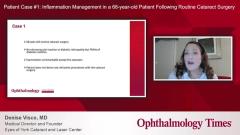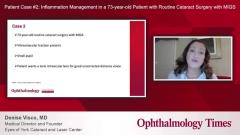
Patient Case #2: Inflammation management in a 73-year-old patient with routine cataract surgery with MIGS
Denise Visco, MD, MBA, reviews inflammation management in a 73-year-old patient with routine cataract surgery with microinvasive glaucoma surgery (MIGS).
Denise Visco, MD, MBA: Our second case discussion was the 73-year-old also presenting for routine cataract surgery. However, they also have primary open-angle glaucoma, and our candidate for [microinvasive] glaucoma surgery with their cataract surgery. Unfortunately, they also have epiretinal membranes, so vitreomacular traction is an issue for them. Small pupil dilating approximately to 4.5 mm to 5 mm. This patient also wants a toric lens for uncorrected distance vision. The cylinder correction is approximately 2 diopters against the rule. The initial impression of this case with our group had many challenges. We’re concerned with the vitreomacular traction that the patient is a high risk for CME [cystoid macular edema], we know we’re going to have additional manipulation in the eye with potentially a small pupil also having to perform the MIGS [microinvasive glaucoma surgery] procedure. And, the expectation for this patient with wanting a premium procedure is also elevated. We have a heightened challenge here in delivering a great experience for this individual. The most appropriate anti-inflammatory regimen for eyes at risk for CME, as agreed by the group, [is] that patients should be getting their drops 2 to 3 days preoperatively and nonsteroidals as part of that regimen. And a significant portion of the group also felt that topical steroids were appropriate for this patient.
TRANSCRIPT EDITED FOR CLARITY
Newsletter
Don’t miss out—get Ophthalmology Times updates on the latest clinical advancements and expert interviews, straight to your inbox.

















































